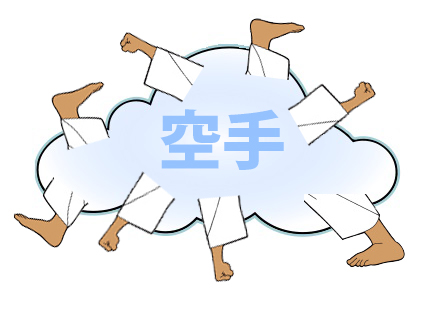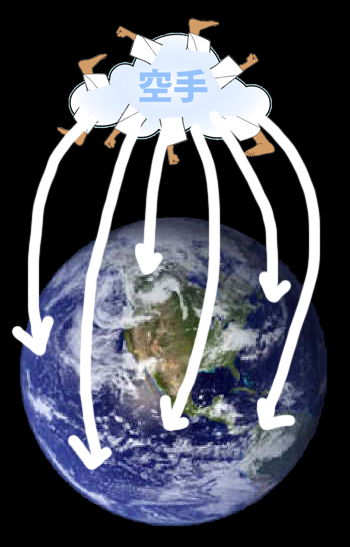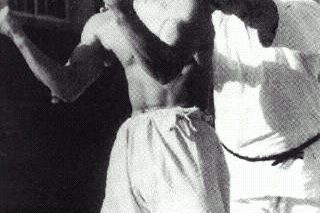I don’t know about you, but I have tons of metaphors for describing Karate.
Most of them are pretty strange, involving stuff like cookie dough and M&’M’s (just… just don’t ask), but some of them are more comprehensible.
One of my favorites is “the cloud”:
Imagine for a second that Karate was originally a gigantic “cloud” emerging from the far away Ryukyuan island of Okinawa. A great cloud consisting of a plethora of scattered ideas, tactics, techniques, tricks, theories and skills related to civil self-defense – collectively referred to as Karate.
Nothing was ever written in stone.
While some Karate pioneers adviced for certain theories and ideas (for instance Itosu Anko felt it was very important to emphasis the stomp in kata Naihanchin/Tekki), other masters advocated the exact opposite (Motobu Choki taught his close student Nakama Chozo that having a swift and silent stomp in Naihanchin/Tekki is very important). [Source: Nakamoto Masahiro, oral testimony].
Karate was a cloud consisting of a bunch of general ideas of self-defense, as taught and shared by different individuals, with different skills, during different times, on an island.
The reason I use a cloud is because you can’t really grab a hold of a cloud.
It’s non touchy.
Ungraspable.

Now, really interesting stuff happens when winds start to blow.
Slowly, the Karate cloud travels over the seven seas, throughout the world, casting a visible shadow over different cultures and continents that is floats over. And obviously, in that shadow stands certain individuals with highflying plans, who see a chance to reach up and rip away a piece of this cloud for themselves.
Gradually, as the cloud soars the world, more and more people reach up and pull a piece down; using that small piece to bring fortune and fame for themselves as they “educate” their fellow citizens about the wisdom and knowledge inherited in their precious piece of white fluff.
Sometimes they might even tell people (either because they truly believe so, or because they want to deceive people) that they are holding the whole cloud in their hands!
Regular people don’t know, of course, that it’s merely a fraction.

In this way, the small pieces of cloud that we are seeing all over the world today are but a tiny part of the original Karate cloud.
And not only that, but these cloud pieces are today applied and studied through a different set of cultural (and moral) eyeglasses, which contort and color the view of the cloud, giving it a totally different appearance and meaning (in favour of the time and place you live in). The relatively modern Okinawa-Japan WW2 Karate 3K (Kata, Kihon, Kumite) war machine support movement is a fine example of this (hint: it’s still going on in other countries).
Hey, I never said my metaphors were easy to follow!
But that still doesn’t mean they don’t totally rock.
Anyhoo… this whole “original-Karate-cloud-spreading-over-the-world-being-chopped-up-and-twisted” gave (and continually gives) birth to most of the difficulties we are experiencing today in Karate. Because those valuable shredded pieces of the Karate cloud are in fact often stored in…
Yup, you guessed it.
All over the world.
One of my favorites being perhaps best summed up and exemplified in the following famous quote, apparently said by the late Ed Parker, grandmaster and founder of “American Kempo Karate”:
“When pure knuckles meet pure flesh, that’s pure Karate…”
I really don’t agree – at all – but the quote is very understandable when you think about the cloud metaphor. Think about it. In fact, many (maaaaaany!) people have a similar view of Karate. It’s about being brutal. About punching people in the teeth. About being proud of yourself and your country, and not taking crap from anyone. It’s about showing no mercy, being a big boss, being a… man?
In linguistics we would call this “bollocks”.
Please, please, don’t soil the painting of Karate with your nationalistic, flag-waving, macho-man finger paint. And no amount of Freudian bad-childhood-memories-that-you-need-to-compensate-for-in-your-adult-life paint either.
Just stop it.
As if to add insult to injury, the Ed Parker quote (which I am sure went straight to the hearts of his target market) has the word “pure” in it, as to say “look, dude, I know you’re very stressed out in this crazy world, and that Karate is very complex and time-consuming, so I’ve broken it down for you into it’s pure essence, and this is it:”.
No.
Sorry.
It’s not.
Looking back at the original cloud of Karate, we find numerous quotes which tell us that Karate is something completely other than destruction, hurting, maiming or killing stuff/people. In fact, letting your “pure” knuckles meet somebody’s “pure” flesh seems to be the least of what “pure” Karate really is. I mean, just have a look at these examples:
- Matsumora Chikudoun Pechin Kosaku [1829 – 1898], perhaps the most prominent authority of old Tomari-te style Karate maintained that, “mastery of Karate-jutsu was never made possible without first illuminating the “world within”.
- Mabuni Kenwa [1889-1952], founder of Shito-ryu Karate, concluded that understanding the deepest meaning of Karate-do first and foremost meant transcending ego-related distractions to find inner-peace (which he made perfectly clear in a brilliant poem where he wrote that “when the spirit of Karate (Bu) is deeply embraced it becomes the vehicle (a boat) in which one is ferried across the great void to the “world within” (described as “bu”-island).
- Motobu Choki [1871-1944] a principal authority of Karate-jutsu, and unquestionably one of the historically most controversial figures in Karate, wrote in 1927, that “in seeking to understand the essence of Karate we must search beyond the immediate results of physical training and not place too much emphasis upon competition or record breaking but rather to seek wisdom through self knowledge and humility.”
- “Bushi” Matsumura Chikudoun Pechin Sokon [c 1809-1901], the Miyamoto Musashi of the Ryukyu Kingdom, who was regarded in Karate history as the principal authority of the self-defense traditions that ascended in the castle district of Shuri (Shurei-te), once wrote; “To all those whose progress remains hampered by ego-related distractions let humility, the spiritual cornerstone upon which karate rest, serve to remind one to place virtue before vice, values before vanity and principles before personalities.” [source: P. McCarthy, “Ancient Okinawan Martial Arts”]
And then of course we have the same ol’ numerous Funakoshi quotes (“perfection of character…”, “clean up your room…” etc.).
See what I’m getting at?
To me, it is amusing how this macho Karate mentality previously described not only goes against every moral fibre deep inside all normal people (who sometimes seem to have an urge to publicly state the opposite, probably due to lack of self-confidence) but also how this regrettably carries over to other philosophies and ideas in Karate, like “Karate ni sente nashi”.
For those of you who have no clue, “Karate ni sente nashi” is a famous saying in Karate, often translated as “There is no first attack in Karate”.
This, of course, is just for girls.
Right?
Real Karate Warriors© have no problem striking first, letting the pure flesh of their enemy meet their pure knuckles. I mean, if somebody is eyeballing you, just punch them in the mouth, right? It’s cool. It’s hip. It’s awesome. It’s “pure” Karate.
And to back it up, these people often choose to pull out the big gun, namely quoting the Japanese military strategy of “go no sen, sen no sen, sen sen no sen” [basic explanation here for you newbs], saying that attacking before your opponent does is perfectly allright, because it is a part of ancient Japanese military strategy.
Sure it is.
But that’s not the point.
If you have ever studied even a tiny bit of Japanese, you will have learnt that the particle “ni” (as in “Karate ni sente nashi”) has numerous meanings. “To” something, “in” something, “at” something, or “on” something being the most common. In other words, it is a directional particle, indicating toward who or what the action of a verb (in this case sente – “attack”) is directed.
So, now that you know this, have you ever considered another meaning for “Karate ni sente nashi”?
- “There is no first attack in Karate”
- “There is no first attack against/towards Karate”
That second translation is just as linguistically correct as the first (popular) one. But it changes the meaning completely, doesn’t it?
In fact, I would say that the meaning now becomes similar to the famous Vegetius’ quote on warfare in the ancient Roman empire:
“Igitur qui desiderat pacem, praeparet bellum.”
(“If you want peace, prepare for war”)
– “Epitoma Rei Militaris,” by Vegetius (Publius Flavius Vegetius Renatus)
Karate is not war.
No matter how much you, your culture, your sensei, your grandmaster, your nation or your friends want it to be.
Karate is achieving peace, through preparing for war.
There is no “first attack” against Karate, because the reason for our whole art’s existance is preparing against perhaps, possibly, eventually, maybe one day in the future being attacked. Think, no, REALLY think about it. When you go to sleep tonight, think about how that ancient Roman Vegetius dude – who lived over a thousand years (!) before Karate was even formulated – knew a lot more about Karate and its cornerstones than most of us do today.
Protecting… defending. Understanding through preparing. Humbleness.
Not mindlessly attacking and destroying.
But, as long the trashed cloud of Karate continues to slowly float around our atmosphere, casting shadows over new places here and there, with fortune hunters continually ripping it apart and examining it through their different sets of glasses, I guess we have nothing left to do but concur with Konishi Yasuhiro [1893-1983] one of the most influential pioneers of modern Karate, who once wrote that:
“Karate strives to build character, improve human behavior and encourage modesty.
It cannot, however, guarantee it.”



18 Comments